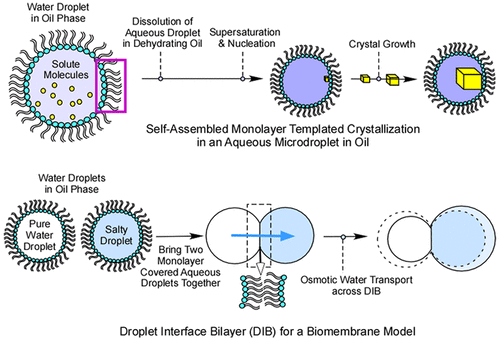当前位置:
X-MOL 学术
›
Acc. Chem. Res.
›
论文详情
Our official English website, www.x-mol.net, welcomes your
feedback! (Note: you will need to create a separate account there.)
Good to the Last Drop: Interfacial Droplet Chemistry, from Crystals to Biological Membranes
Accounts of Chemical Research ( IF 16.4 ) Pub Date : 2018-09-24 00:00:00 , DOI: 10.1021/acs.accounts.8b00277 Sunghee Lee 1
Accounts of Chemical Research ( IF 16.4 ) Pub Date : 2018-09-24 00:00:00 , DOI: 10.1021/acs.accounts.8b00277 Sunghee Lee 1
Affiliation

|
The study of the liquid–liquid interface has a long and storied history yet still holds important implications for science and technology. Although deep examination of this buried interface poses challenges, recent progress in experimental and theoretical methodology has allowed for advanced understanding of the molecular bases of such interfaces. This Account will focus on the behavior of surfaces of aqueous microdroplets immersed in an immiscible phase, exhibiting physicochemical behavior dependent on the presence of interfacial self-assembled structures. Amphiphiles spontaneously form self-assembled nanostructures at the liquid interface, creating a soft liquid surface for the aqueous microdroplet that can modulate its behavior. A prominent characteristic of a micron-sized droplet is its elevated surface area/volume ratio, a feature that presents opportunities for investigating the role of the interface in aspects of droplet chemistry. In two notable examples, a surfactant self-assembly can act as a template for crystal nucleation of droplet solutes at the monolayer level, while at the level of a bilayer, formed when two monolayer-covered droplets are made to adhere, the apposition of monolayers bears remarkable similarities to cell membranes. Each type of system provides arbitrary control of important factors, both for studying crystallization nucleation and for modeling semipermeable lipid membranes at an interdroplet contact zone, the droplet interface bilayer (DIB). The droplet bilayer allows for direct observation of species transport across an unsupported bilayer and versatile parameter control to expore the effects of membrane lipid structure on bilayer transport. It is demonstrated that molecular shape for monoglycerides and phospholipids influences the surface characteristics of monolayers and bilayers. Additionally, subtle interfacial interactions between aqueous contents (ions, solutes) and the monolayer/bilayer are shown to have a marked influence on lipid packing and permeability. It is anticipated that this successful demonstration of surface engineering at the micron scale will deliver cogent insights into many biologically relevant phenomena, such as membrane transport and biomineralization.
中文翻译:

对最后一滴有用:界面液滴化学,从晶体到生物膜
液-液界面的研究历史悠久,历史悠久,但对科学技术仍具有重要意义。尽管对该埋藏界面的深入检查提出了挑战,但实验和理论方法的最新进展已使人们对这种界面的分子基础有了更深入的了解。该帐户将重点研究浸没在不混溶相中的水微滴表面的行为,表现出取决于界面自组装结构存在的理化行为。两亲物在液体界面处自发形成自组装的纳米结构,从而为水性微滴形成柔软的液体表面,从而可以调节其行为。微米级液滴的显着特征是表面积/体积比提高,该功能为研究界面在液滴化学方面的作用提供了机会。在两个显着的例子中,表面活性剂的自组装可以充当单层水平的液滴溶质晶体成核的模板,而在双层的水平上,当使两个单层覆盖的液滴粘附在一起时形成的双层结构与细胞膜有着惊人的相似之处。每种类型的系统都可以对重要因素进行任意控制,以研究结晶成核作用以及在液滴间接触区(液滴界面双层(DIB))上对半透性脂质膜进行建模。液滴双层允许直接观察跨无支撑双层的物种运输,以及通用的参数控制以表达膜脂质结构对双层运输的影响。已经证明,甘油单酸酯和磷脂的分子形状影响单层和双层的表面特性。此外,水含量(离子,溶质)与单层/双层之间的微妙的界面相互作用显示出对脂质堆积和渗透性的显着影响。可以预期,这种成功的微米级表面工程演示将为许多生物相关现象(如膜运输和生物矿化)提供有力的见解。已经证明,甘油单酸酯和磷脂的分子形状影响单层和双层的表面特性。此外,水含量(离子,溶质)与单层/双层之间的微妙的界面相互作用显示出对脂质堆积和渗透性的显着影响。可以预期,这种成功的微米级表面工程演示将为许多生物相关现象(如膜运输和生物矿化)提供有力的见解。已经证明,甘油单酸酯和磷脂的分子形状影响单层和双层的表面特性。此外,水含量(离子,溶质)与单层/双层之间的微妙的界面相互作用显示出对脂质堆积和渗透性的显着影响。可以预期,这种成功的微米级表面工程演示将为许多生物相关现象(如膜运输和生物矿化)提供有力的见解。
更新日期:2018-09-24
中文翻译:

对最后一滴有用:界面液滴化学,从晶体到生物膜
液-液界面的研究历史悠久,历史悠久,但对科学技术仍具有重要意义。尽管对该埋藏界面的深入检查提出了挑战,但实验和理论方法的最新进展已使人们对这种界面的分子基础有了更深入的了解。该帐户将重点研究浸没在不混溶相中的水微滴表面的行为,表现出取决于界面自组装结构存在的理化行为。两亲物在液体界面处自发形成自组装的纳米结构,从而为水性微滴形成柔软的液体表面,从而可以调节其行为。微米级液滴的显着特征是表面积/体积比提高,该功能为研究界面在液滴化学方面的作用提供了机会。在两个显着的例子中,表面活性剂的自组装可以充当单层水平的液滴溶质晶体成核的模板,而在双层的水平上,当使两个单层覆盖的液滴粘附在一起时形成的双层结构与细胞膜有着惊人的相似之处。每种类型的系统都可以对重要因素进行任意控制,以研究结晶成核作用以及在液滴间接触区(液滴界面双层(DIB))上对半透性脂质膜进行建模。液滴双层允许直接观察跨无支撑双层的物种运输,以及通用的参数控制以表达膜脂质结构对双层运输的影响。已经证明,甘油单酸酯和磷脂的分子形状影响单层和双层的表面特性。此外,水含量(离子,溶质)与单层/双层之间的微妙的界面相互作用显示出对脂质堆积和渗透性的显着影响。可以预期,这种成功的微米级表面工程演示将为许多生物相关现象(如膜运输和生物矿化)提供有力的见解。已经证明,甘油单酸酯和磷脂的分子形状影响单层和双层的表面特性。此外,水含量(离子,溶质)与单层/双层之间的微妙的界面相互作用显示出对脂质堆积和渗透性的显着影响。可以预期,这种成功的微米级表面工程演示将为许多生物相关现象(如膜运输和生物矿化)提供有力的见解。已经证明,甘油单酸酯和磷脂的分子形状影响单层和双层的表面特性。此外,水含量(离子,溶质)与单层/双层之间的微妙的界面相互作用显示出对脂质堆积和渗透性的显着影响。可以预期,这种成功的微米级表面工程演示将为许多生物相关现象(如膜运输和生物矿化)提供有力的见解。











































 京公网安备 11010802027423号
京公网安备 11010802027423号